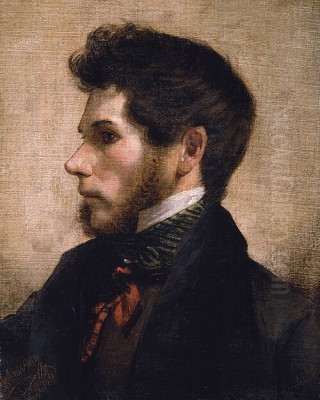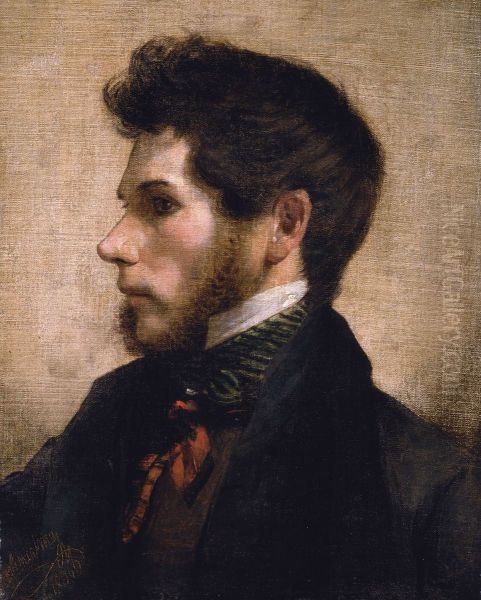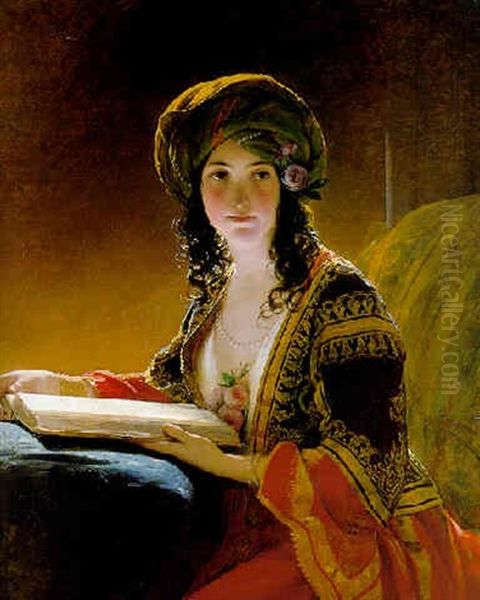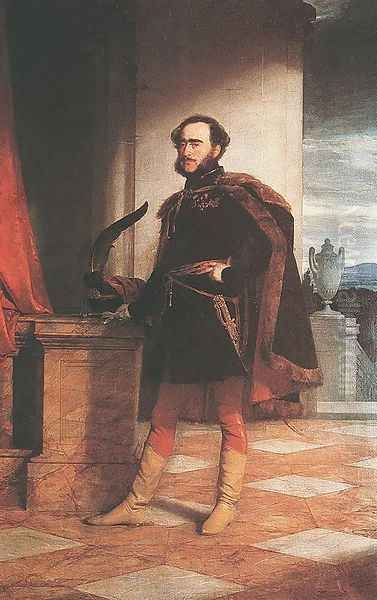
Friedrich von Amerling stands as one of the most significant figures in 19th-century Austrian art. Alongside Ferdinand Georg Waldmüller, he dominated the Viennese portrait scene for decades, particularly during the Biedermeier period. His work, characterized by technical brilliance, elegant realism, and psychological insight, captured the likenesses of emperors, aristocrats, bourgeois families, and fellow artists, leaving behind a rich visual chronicle of his time. This article delves into the life, art, and enduring legacy of this quintessential Viennese master.
Early Life and Artistic Awakening
Friedrich Amerling was born on April 14, 1803, in Spittelberg, then a suburb of Vienna. He came from an artisanal background; his father, Franz Amerling, was a gold and silver wire drawer, and his mother was Theresia Kargl. This connection to craftsmanship perhaps instilled in him an early appreciation for precision and material quality, traits that would later manifest in his meticulous painting technique. His artistic inclinations were recognized early, leading him to formal training.
From 1815 to 1824, Amerling embarked on his foundational artistic education at the Academy of Fine Arts Vienna. During this period, he studied under several instructors, initially learning engraving from Josef Klieber before transitioning to painting. A key figure in his early development was the conservative history painter Hubert Maurer, whose academic approach provided Amerling with a solid grounding in drawing and composition. He also attended classes taught by Karl Gsellhofer, further honing his skills within the established academic framework of the time.
Seeking broader horizons and more diverse instruction, Amerling moved to Prague in 1824. There, he enrolled at the Academy of Fine Arts and studied under Joseph Bergler the Younger. Bergler, also primarily a history painter and draughtsman rooted in the late Baroque and Neoclassical traditions, likely reinforced the academic discipline Amerling had acquired in Vienna. His time in Prague, though relatively brief, added another layer to his burgeoning artistic education before he ventured further afield.
The Transformative London Sojourn

A pivotal moment in Amerling's artistic development occurred between 1827 and 1828 when he traveled to London. The primary draw was the opportunity to study with Sir Thomas Lawrence, the preeminent portrait painter in England and President of the Royal Academy. Lawrence's style – characterized by its fluid brushwork, elegant compositions, sophisticated use of color, and flattering yet insightful portrayals – profoundly influenced the young Austrian artist.
Under Lawrence's guidance, Amerling absorbed the techniques and aesthetic sensibilities that defined British Regency portraiture. He learned to combine meticulous detail with a sense of painterly freedom, to capture not just a likeness but also the sitter's social standing and personality. The emphasis on vibrant color, dramatic lighting, and the rendering of luxurious fabrics, hallmarks of Lawrence's work, would become integral components of Amerling's own mature style. This period marked a significant departure from the more rigid academicism he had known, infusing his work with a new dynamism and elegance.
The London experience was crucial. It exposed Amerling to a different artistic milieu and connected him to the lineage of great British portraitists like Sir Joshua Reynolds and Thomas Gainsborough, whose influence was still palpable. Lawrence's international renown and his ability to create portraits that were both artistically accomplished and socially desirable provided a powerful model for Amerling's future career aspirations.
Travels and Broadening Influences: Paris and Rome
Following his formative stay in London, Amerling continued his travels, seeking further inspiration and knowledge in the major art centers of continental Europe. He spent time in Paris, immersing himself in the vibrant artistic scene of the French capital. Here, he encountered the burgeoning Romantic movement, exemplified by artists like Eugène Delacroix and Théodore Géricault. While Amerling never fully embraced the dramatic intensity of French Romanticism, its emphasis on emotion, color, and individual expression likely resonated with him and subtly informed his evolving style.
His journey then took him to Rome, the historical heart of classical and Renaissance art. In Italy, he studied the Old Masters, absorbing lessons in composition, anatomy, and idealized form. The influence of Italian art, particularly the High Renaissance and the precision of painters like Jean-Auguste-Dominique Ingres (though French, Ingres spent significant time in Rome and his influence was felt there), can be seen in the clarity of line and structural solidity that underpin Amerling's portraits, balancing the painterly qualities learned from Lawrence.

During his time in Rome, Amerling received a significant commission that helped launch his career upon his return to Austria. He was tasked with painting a full-length portrait of Emperor Franz I of Austria. Successfully completing this prestigious commission demonstrated his skill and reliability, paving the way for future imperial patronage and solidifying his reputation before he even resettled in Vienna. These travels were not mere sightseeing trips; they were essential periods of study, absorption, and synthesis that equipped Amerling with a diverse artistic toolkit.
Return to Vienna and Rise to Prominence
Armed with international experience and a growing reputation, Friedrich Amerling returned to Vienna in 1828. He quickly established himself as a leading portrait painter, his sophisticated style appealing to the Austrian aristocracy and the increasingly affluent bourgeoisie. His ability to blend the elegance learned from Lawrence with a distinct Viennese sensibility proved highly successful.
A major breakthrough came with the aforementioned portrait of Emperor Franz I, completed after his return based on studies made in Rome. This work was well-received and led to further commissions from the imperial court and high nobility. His talent was officially recognized early on; in 1829, he received the Reichel Prize from the Vienna Academy of Fine Arts, signaling his acceptance by the city's artistic establishment.
From 1835 until 1880, Amerling held the prestigious position of court painter to Emperor Franz Joseph I (who succeeded Ferdinand I in 1848, though Amerling's favor began under Franz I and continued). This long tenure cemented his status as the premier portraitist in the Austrian Empire. He became the painter of choice for the Habsburgs, the Liechtenstein family, and numerous other noble houses, as well as wealthy industrialists, merchants, artists, and intellectuals. His studio became a hub of Viennese society.
The Biedermeier Context and Amerling's Role
Amerling's career flourished during the Biedermeier period (roughly 1815-1848) in the Austrian Empire. This era, characterized by political conservatism under Metternich following the Napoleonic Wars, saw a cultural shift towards the domestic sphere, intimacy, sentiment, and an appreciation for realism in the arts. It was a time when the middle class gained cultural prominence, and art often focused on portraiture, genre scenes, and landscapes that reflected bourgeois values and everyday life.
Amerling is considered one of the foremost painters of the Biedermeier era, alongside contemporaries like Ferdinand Georg Waldmüller, Peter Fendi, and Josef Danhauser. While Waldmüller often focused on detailed realism, sometimes with a sharper, more critical edge, Amerling generally presented a more idealized and elegant vision, particularly in his aristocratic portraits. However, he also excelled at capturing the comfortable domesticity and individual character valued during this period, especially in his portraits of bourgeois families and children.

His work embodies many Biedermeier ideals: technical perfection, a focus on accurate representation, an interest in textures and materials, and the portrayal of individual personality within a social context. Yet, his style, refined by his international experiences, possessed a cosmopolitan elegance that sometimes transcended the perceived provincialism occasionally associated with Biedermeier art. He navigated the demands of representing both imperial power and bourgeois intimacy with remarkable skill.
Artistic Style: Elegance, Realism, and Psychological Depth
Friedrich von Amerling's artistic style is a sophisticated blend of Neoclassical clarity, Romantic sensitivity, and the elegant realism he absorbed from Sir Thomas Lawrence. His primary medium was oil painting, and he demonstrated exceptional technical mastery throughout his long career.
A defining feature of Amerling's work is the combination of precise drawing and fluid brushwork. The underlying structure of his figures is solid and well-defined, reflecting his academic training and possibly the influence of Ingres. However, this precision is often softened by a painterly handling of surfaces, particularly in the rendering of clothing, hair, and backgrounds. He was a master at depicting textures – the sheen of silk, the softness of velvet, the richness of fur, the glint of jewelry – which added to the luxurious feel of many of his portraits.
His use of color is notable for its richness and warmth. He often employed a harmonious palette, favoring deep reds, warm browns, and luminous skin tones, creating an overall effect of opulence and vitality. Lighting in his portraits is typically carefully controlled, often highlighting the sitter's face and hands while allowing other areas to recede into shadow, adding a sense of drama and focus. This skillful use of chiaroscuro enhances the three-dimensionality of the figures and contributes to the psychological intensity of the portrayal.
Beyond technical skill, Amerling possessed a keen ability to capture the personality and inner life of his sitters. While his portraits are often flattering, adhering to the conventions expected by his elite clientele, they rarely feel superficial. He conveyed individuality through subtle nuances of expression, posture, and gaze, suggesting the sitter's character, mood, or social role. This psychological depth elevates his work beyond mere likeness-taking.
Masterpieces and Key Works: A Portfolio
Over his prolific career, Amerling produced more than a thousand paintings, the vast majority being portraits. Several stand out as representative masterpieces:
_Portrait of Emperor Franz I of Austria_ (c. 1832): This official portrait, painted in full regalia, established Amerling's credentials as a court painter. It combines imperial dignity with a sense of the aging monarch's personality, showcasing Amerling's ability to balance formality and humanity. It exists in several versions and hangs in locations like the Hofburg Imperial Palace.
_Rudolf von Arthaber and his Children_ (1837): Housed in the Belvedere Museum, Vienna, this painting is a quintessential Biedermeier group portrait. It depicts the wealthy textile merchant and art collector Rudolf von Arthaber in his home, surrounded by his children. The composition emphasizes domestic harmony and paternal affection, capturing the textures of the interior and the individual personalities of the family members with warmth and detail.
_Girl with Straw Hat_ (1835): This charming portrait became one of Amerling's most famous works, particularly after its record-breaking sale in 2008. It depicts a young girl, possibly modeled by Elise Kreuzberger, with a direct, engaging gaze. The painting exemplifies Amerling's skill in rendering youthful innocence, combined with masterful technique in the depiction of the straw hat, clothing, and luminous skin tones.
_The Young Eastern Woman_ (1838): Reflecting the 19th-century fascination with the Orient, this work (now in the Cleveland Museum of Art) depicts a young woman in imagined Turkish attire. It showcases Amerling's rich color palette and skill in rendering exotic fabrics and details, participating in the popular Orientalist genre explored by artists across Europe, including Delacroix and Ingres.
_Princess Maria Franziska of Liechtenstein_ (1836): This delightful portrait of the two-year-old princess (part of the Princely Collections of Liechtenstein, Vaduz-Vienna) is a prime example of Amerling's sensitive portrayal of children. He captures her youthful energy and innocence within an elegant composition, demonstrating his strong relationship with one of Austria's most prominent noble families.
_Self-Portrait_ (various dates): Amerling painted several self-portraits throughout his life. One notable example is said to have been painted during a brief period of imprisonment for debt, showing the artist in a moment of introspection. These works offer valuable insights into how the artist saw himself and charted his own aging process.
_Portrait of the Sculptor Josef Klieber_ (c. 1842): Amerling often painted fellow artists. This portrait of his former teacher showcases his ability to convey the sitter's profession and intellectual intensity. Other artist portraits include one of the landscape painter Thomas Ender.
These examples highlight the range of Amerling's portraiture, from imperial grandeur to bourgeois intimacy, from exotic fantasies to sensitive depictions of children and fellow creatives.
Portraits of Power, Intimacy, and Society
Amerling's primary contribution lies in his vast oeuvre of portraits, which collectively offer a panorama of Austrian society in the 19th century. He moved seamlessly between different social strata, adapting his style to suit the sitter and the context.
His portraits of the Habsburg emperors, Franz I and later Franz Joseph I, were crucial for disseminating the imperial image. These works required a balance between conveying authority and projecting a relatable, albeit dignified, persona. Amerling navigated these demands skillfully, creating images that served their official purpose while retaining artistic merit. His numerous commissions from the aristocracy, such as the extensive work for the Princes of Liechtenstein, further cemented his status. He depicted figures like Princess Maria Franziska or Baroness Cecil von Eskeles with an elegance and refinement befitting their station.
Simultaneously, Amerling was highly sought after by Vienna's burgeoning upper-middle class. Portraits like Rudolf von Arthaber and his Children exemplify his ability to capture the values of this group: family, prosperity, cultural refinement, and domestic comfort. He portrayed industrialists, bankers, merchants, scholars, and their families, documenting their rise and their aspirations. These works often have a greater sense of intimacy and informality compared to his aristocratic commissions.
He also painted portraits of his own family members, such as his father Andreas Amerling or his daughter Ludmilla. These works, often undertaken for personal reasons, sometimes reveal a more relaxed and experimental side of his art. His portraits of fellow artists, writers, and musicians demonstrate his integration into Vienna's cultural life and his respect for creative peers like the sculptor Josef Klieber or the painter Thomas Ender.
Beyond Portraiture: Other Genres and Orientalism
While overwhelmingly known as a portraitist, Friedrich von Amerling did occasionally venture into other genres, though these form a much smaller part of his output. He produced some history paintings, often drawing on classical or biblical themes, aligning with the academic training he received under masters like Hubert Maurer and Joseph Bergler. These works, however, generally did not achieve the same level of acclaim or frequency as his portraits.
He also painted a number of genre scenes, often depicting sentimental or anecdotal subjects characteristic of the Biedermeier period. These scenes typically focused on everyday life, family interactions, or moments of quiet contemplation, echoing the themes found in the works of artists like Peter Fendi or Josef Danhauser, though perhaps with Amerling's characteristic touch of elegance.
Landscape painting also appears intermittently in his oeuvre, often featuring Italianate scenes inspired by his travels or Austrian vistas. These landscapes usually served as studies or personal works rather than major public commissions. His handling of landscape often shows a sensitivity to light and atmosphere, complementing the skills honed in his portrait backgrounds.
A distinct category within his work is Orientalism, exemplified by paintings like The Young Eastern Woman. This fascination with the "Orient" (primarily the Ottoman Empire and North Africa) was a widespread phenomenon in 19th-century European art, fueled by travel, literature, and colonial expansion. Artists like Delacroix, Ingres, and later Jean-Léon Gérôme explored these themes extensively. Amerling's contributions, while fewer in number, tapped into this popular taste for the exotic, allowing him to showcase his mastery of color and texture in depicting imagined scenes and costumes.
The Artist as Collector and Cultural Figure
Friedrich von Amerling was more than just a successful painter; he was also a prominent figure in Viennese cultural life and an avid art collector. His success allowed him to amass considerable wealth, which he invested partly in acquiring art and antiques. His collection reportedly included valuable old master paintings, weapons, tapestries, furniture, and various objets d'art. This activity reflects not only his personal taste but also the growing trend of private collecting among the affluent classes in the 19th century.
In 1858, Amerling acquired the Gumpendorf Castle on the outskirts of Vienna, which had formerly belonged to the Esterházy family. He renovated and lavishly furnished it according to his tastes, renaming it the "Amerling Palace" (Amerlingschlössl). This residence became a significant cultural salon, where Amerling hosted gatherings of artists, writers, musicians, and prominent members of Viennese society. Figures like the dramatist Franz Grillparzer were reportedly among his acquaintances. The Amerlingschlössl functioned as both a showcase for his collection and a center for social and intellectual exchange.
Amerling's personal life was also eventful. He married four times: Antonie Kaltenthaler (died 1843), Katharina Heissler (died 1844 shortly after marriage), Emilie Heinrich (married 1857, divorced 1880), and finally Maria Nemetschke (married 1881). These relationships, along with his active social life and friendships with leading cultural figures, placed him at the heart of Vienna's artistic and social world for much of his adult life. His status was further confirmed in 1878 when he was elevated to the nobility, becoming Friedrich Ritter von Amerling, and received the Order of the Iron Crown.
Teaching and Influence on Later Generations
While primarily known for his own artistic output, Friedrich von Amerling also played a role as an educator, influencing the next generation of painters, particularly those from Hungary who came to study in Vienna. Vienna, as the imperial capital, was a major center for artistic training, attracting students from across the Habsburg Empire.
One of his most notable pupils was the Hungarian painter József Borsos (1821-1883). Borsos studied with Amerling in Vienna and became known for his own portraits and genre scenes, often reflecting the Biedermeier style he absorbed from his master. Amerling's emphasis on technical finish, rich color, and psychological insight left a discernible mark on Borsos and other Hungarian artists who passed through his circle or were influenced by his dominant presence in the Viennese art scene.
Amerling's influence extended beyond direct tutelage. His immense success and visibility set a standard for portraiture in Vienna and the wider empire for decades. Younger artists inevitably had to engage with his work, either by emulating his style or reacting against it. His elegant realism provided a benchmark against which later trends, such as the more robust realism of the Gründerzeit or the emerging currents of Impressionism and Symbolism towards the end of the century, would be measured. While his style eventually fell out of fashion, his technical mastery remained respected.
Later Years, Legacy, and Honors
Friedrich von Amerling enjoyed a long and remarkably successful career, remaining active as a painter well into his later years. His ennoblement in 1878 was a significant honor, recognizing his decades of service to the imperial court and his contributions to Austrian art. He continued to receive commissions and participate in Vienna's cultural life, although the dominant artistic styles began to shift away from the Biedermeier elegance he perfected.
He passed away on January 14, 1887, in Vienna, at the age of 83. His death marked the end of an era in Austrian painting. In recognition of his stature, a street in Vienna, Amerlingstrasse, was named in his honor in 1887. His extensive art collection and the contents of his Amerlingschlössl were eventually dispersed. A significant portion of his estate was auctioned in 1916, with proceeds benefiting a foundation for Viennese artists, ensuring his legacy continued to support the artistic community.
Today, Amerling's works are held in major museums across Austria and internationally, including the Belvedere Museum and the Albertina in Vienna, the Liechtenstein Princely Collections in Vaduz-Vienna, the Germanisches Nationalmuseum in Nuremberg, the Museum of Fine Arts in Budapest, and the Cleveland Museum of Art. His paintings remain highly valued both as exquisite examples of 19th-century portraiture and as historical documents capturing the faces and spirit of imperial Vienna.
Market Reception and Collecting History
Friedrich von Amerling's works have consistently been sought after by collectors, particularly his portraits. During his lifetime, he commanded high fees, reflecting his status as a court painter and the preferred artist of the aristocracy and wealthy bourgeoisie. His patrons included not only the Emperor and the Princes of Liechtenstein but also prominent collectors like Rudolf von Arthaber.
After his death, his reputation endured, and his works continued to appear in significant collections and at auction. The 1916 auction of his estate was a major event. In the 20th and 21st centuries, his paintings have maintained a strong presence on the art market, especially within Austria and Germany.
A notable high point in his posthumous market history occurred in 2008 when his painting Girl with Straw Hat (1835) was sold at the Dorotheum auction house in Vienna for a record price of €1.5 million (approximately $2.3 million at the time), making it one of the most expensive Austrian paintings sold at auction up to that point. This sale significantly boosted international awareness of Amerling's work.
While not all his works command such high prices, his major portraits, particularly those of identifiable historical figures or those exhibiting exceptional quality and charm, continue to perform well at auction. Recent sales and auction estimates, such as those for his self-portraits or works like The Young Eastern Woman, indicate sustained interest from collectors and institutions. His paintings are considered key examples of Biedermeier art and essential components of any serious collection focusing on 19th-century European portraiture.
Conclusion: An Enduring Legacy
Friedrich von Amerling remains a towering figure in Austrian art history. As the leading portrait painter in Vienna for nearly half a century, he created an unparalleled visual record of the Austrian Empire during a period of significant social and cultural transition. His art skillfully blended the academic precision of his training, the painterly elegance absorbed from Sir Thomas Lawrence, and the intimate realism characteristic of the Biedermeier era.
His portraits captured emperors and princesses, wealthy merchants and their families, fellow artists, and himself, all with remarkable technical finesse and psychological insight. Beyond his artistic output, he was a significant cultural figure, a collector, and a host who shaped the Viennese art scene. While artistic tastes evolved after his death, the quality and historical importance of his work ensure his enduring legacy. Friedrich von Amerling's paintings continue to fascinate viewers with their beauty, craftsmanship, and evocative portrayal of a bygone era.